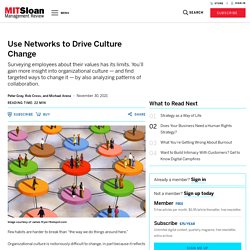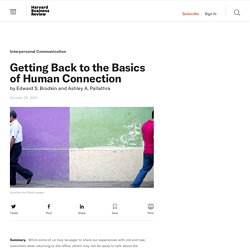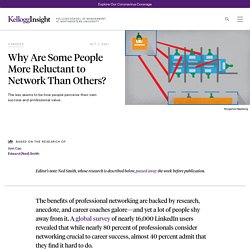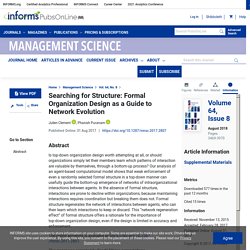

Use Networks to Drive Culture Change. 1.

H. Ibarra, “Take a Wrecking Ball to Your Company’s Iconic Practices,” MIT Sloan Management Review 61, no. 2 (winter 2020): 13-16. 2. For example, see N.M. Ashkanasy, C.P.M. Getting Back to the Basics of Human Connection. While some of us may be eager to share our experiences with old and new coworkers when returning to the office, others may not be ready to talk about the emotionally searing experiences we’ve been through over the past year and a half....

Returning to in-person work can be a tricky process that comes with a complicated mixture of feelings. Whether you’re excited or anxious about reentry, you can expect being around other people to require a lot of energy that you probably haven’t had to expend in a while. Why Are Some People More Reluctant to Network Than Others? Editor’s note: Ned Smith, whose research is described below, passed away the week before publication.

So who networks and who doesn’t? One might assume that networking is largely the domain of those who have lower social status who are early in their careers. Podcast: How Network Effects Rule the World (with James Currier) AZEEM AZHAR: Hi there.

I’m Azeem Azhar, and you’re listening to the Exponential View podcast. Every week, I come together with a brilliant mind to explore how exponential technologies are shaping our near future. This is the first episode after our brief summer hiatus. I missed you. Human Connection. Last week we spoke at an international conference for managing partners of accounting firms (in person!).

We were struck by the wide range of current work situations, from fully back in the office to fully hunkered down at home, depending on the country and state. Amongst all their differences, there was one clear common challenge: attracting and retaining good talent. And for good reason as we are seeing significant movement in the employment market. In fact, a recent Korn Ferry survey showed that currently the #1 reason for leaving jobs is “company culture and purpose” (35% of responses). Podcast: Stop Networking, Start Connecting with Susan McPherson. The New Technology of Teams: How Organizational Network Analysis Can Increase Team Collaboration. What a Year of WFH Has Done to Our Relationships at Work.
Build a Change Network - Growing Enterprise Change Capability. How to network in a remote world. Business magnate Elon Musk is known for leading the way.

From online payments to electric cars, Musk is often ahead of the curve. In February, he demonstrated his business savvy once more when he excelled at networking in a remote world. Using his Twitter account, which has 46.7 million followers, Musk sent a tweet to the Russian President Vladimir Putin and asked if he would like to join him for a conversation on the social networking app Clubhouse. Musk received an immediate reply from the Kremlin, stating the president was “interested”. What Is Your Social Networking Style? If the prospect of networking makes you anxious or uncomfortable, you’re not alone.

Research suggests that many of us feel ambivalent about networking. For instance, we may feel that we don’t have enough time, we may feel inauthentic while networking, or we may worry about how we’re coming across to others. However, according to Marissa King, professor of organizational behavior at the Yale School of Management, we have a lot to gain from overcoming these barriers and making a concerted effort to cultivate our social networks.
In her new book Social Chemistry: Decoding the Elements of Human Connection, King argues that we may be overlooking a key aspect of networking if we just think about how many people we know: instead, we need to pay attention to how our social networks are structured. In other words, networking isn’t just a numbers game. The building blocks of social networks. Report: Designing for adaptive work post COVID-19. Tools such as organizational network analysis (ONA) can provide insights into less visible but arguably more important informal networks within the organization.

ONA examines the structure of social relationships in a group to uncover the informal connections between people (figure 6). It is the science of making visible the key pathways of collaboration and information flow across these networks, beyond the often-hierarchical, formal reporting structures. ONA illuminates how work gets done and who is driving value, where collaboration is breaking down, where talent and expertise can be better leveraged, and where opportunities for diffusion and innovation are being lost.20 In designing adaptive workplaces, ONA can help leaders, managers, and workers understand how they work together, identify potential issues, and lead to actions that ensure the continued well-being and productive engagement of the workforce. Searching for Structure: Formal Organization Design as a Guide to Network Evolution (2017) Is top-down organization design worth attempting at all, or should organizations simply let their members learn which patterns of interaction are valuable by themselves, through a bottom-up process?

Our analysis of an agent-based computational model shows that weak enforcement of even a randomly selected formal structure in a top-down manner can usefully guide the bottom-up emergence of networks of intraorganizational interactions between agents. In the absence of formal structure, interactions are prone to decline within organizations, because maintaining interactions requires coordination but breaking them does not. Comment bien réseauter en période de pandémie? Le «Réseautage Zoom» est à la portée de tous...

Practical Tips for Creating a Network of Change Agents. On building a network of change agents. How, why, and when to build a network of change agents. 4 steps to quickly create a network of teams. June 1, 2020In a rapidly changing environment like the COVID-19 crisis, organizations must respond with urgency. Waiting to make decisions, or even waiting for senior executive approval, is the worst thing they can do. However, some level of coordination across teams and activities is crucial for an effective organizational response. The solution to this challenge lies in creating a robust network of teams, empowered to operate outside of the current hierarchy and bureaucratic structures of the organization. Organizational Network Analytics. Social networks are broken. Here's how to rebuild trust. Research: 5 Social Networks Newcomers In (Self-Managing) Organisations Need. Social capital and social networks are becoming increasingly important in today’s economy at large, and for individuals within organisations.
For my MSc dissertation in Organisational Psychology, I researched how newcomers transition into a self-managing organisation (Lee & Edmondson, 2017), an organisation where authority is decentralised and classic manager-subordinate relationships are absent. The findings reveal that the newcomers’ social networks are central to the adjustment process. However, it is not just any big network that is important for new organisational members to adapt to their novel environment. Rather, novices build networks with different purposes within the organisation, networks that then support adjustment in different ways.
This article describes these networks and how organisations can support the networking process. On fundamental shifts in the underlying fabric of our norms, networks and relationships. NodeXL - Your Social Network Analysis Tool for Social Media. Build a Network — Even When You Don’t Think You Need One. Building A Network One Node At A Time. Interview: Building Change Capability Through Change Agent Networks. What is Organizational Network Analysis? And How Does it Benefit Companies? What organization doesn’t want to do more to break down silos, stimulate innovation, identify hidden talent, and encourage collaboration across teams and functions? Introducing Organizational Network Analysis (ONA) Achieving such innovation, collaboration, and connectivity enables an organization to leverage expertise broadly, well beyond employees’ teams and functions to improve productivity and enable the free flow of knowledge, skills, and resources across the enterprise.
The role of networks in organizational change. A few years ago, the world’s leading designer and manufacturer of office products decided that it needed an organizational overhaul. Coordination across product lines was poor. Design teams collaborated ineffectively. Key personnel were remote from customers. Organizational Network Analysis - Tapping Into Your Hidden Influencers (On demand podcast) The future of connectivity in the age of advanced networking. Finding the right balance with organizational network analysis. How Deeper Relationships Yield Better Results.
Finding the right balance with organizational network analysis. Networks + Hierarchies eBook. Disrupt or be disrupted. That’s the world businesses and organizations around the world are operating in today. How Networks And Hierarchies Can Coexist And Drive Success. Just 12 percent of companies that comprised the Fortune 500 in 1955 were still around by 2015.